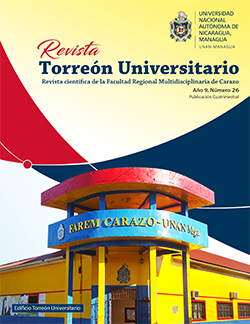Topographic Position Index (TPI) to identify floodable areas and zoning of plant species in a mangrove swamp in the South Pacific of Nicaragua
DOI:
https://doi.org/10.5377/torreon.v9i26.10264Keywords:
TPI, mangrove forest, geomorphology, flooding areas, integrated managementAbstract
COP7 recognized that mangroves are vulnerable ecosystems and threatened by habitat loss and degradation, which need urgent actions to guarantee their conservation and rational use. Geomorphological and hydrological processes are key to the growth and development of mangrove forests. However, in Central America, very few studies exist in this regard. Mangrove forests offer valuable economic and ecological services, such as tourism and shelter for species of flora and fauna. Furthermore, they protect against sea-level rise caused by climate change. The hydrology of the mangrove swamp of Río Ostional, in the South Pacific of Nicaragua, has been studied in recent years suggesting a relationship between mangrove species and freshwater inputs. In this project, the use of the Topographic Position Index (TPI) was explored to identify small-scale floodplains with little variation in elevation in a mangrove swamp. For this, a geomorphological characterization was carried out through a detailed topographic survey of the area and the analysis of the TPI as a method of classifying landforms to identify the flood zones; as well as the zoning of plant species. The classification of the TPI was related to the zoning of species. This relationship will allow the identification of the most sensitive areas to geomorphological modifications of possible anthropic origin, which is an essential input for comprehensive forest management.
Downloads
915
PDF 290
HTML (Español (España)) 363
HTML 125
Downloads
Published
How to Cite
Issue
Section
License
Los autores que publican en esta revista están de acuerdo con los siguientes términos.
- El autor o los autores de los artículos, ensayos o investigaciones conceden a la Universidad Nacional Autónoma de Nicaragua, Managua (UNAN-Managua) los derechos de edición (copyright) del trabajo enviado, por consiguiente la Universidad cuenta con el derecho exclusivo para publicar el artículo durante el periodo completo de los derechos de autor.
- Estos derechos de autor/ autores autorizan a la Revista Torreón Universitario y a la Universidad editar y divulgar/publicar el artículo en dicha Revista, incluyendo reproducción impresa y electrónica, el almacenamiento, recuperación y cualquier otro tipo de publicación, y fuentes de información secundaria como servicios de resúmenes y bases de datos, así mismo la facultan a proteger el artículo contra el uso no autorizado para su difusión por medios impresos o electrónicos (PDF, HTML, EPUB, XML u otros).
Licencia para el uso del contenido
La revista hace uso de la Licencia Creative Commons Atribución-NoComercial-SinDerivar 4.0 Internacional.
Bajo esta declaración:

Este revista está sujeta a una licencia de Creative Commons Reconocimiento-NoComercial-SinObraDerivada 4.0 Internacional. Puede ser copiada, distribuida y transmitida públicamente siempre y cuando se cite al autor y la fuente (Revista Torreón Universitario), no debe modificarse ni utilizarse con ningún fin comercial. La licencia completa se puede consultar en http://creativecommons.org/licenses/by-nc-nd/4.0/.


